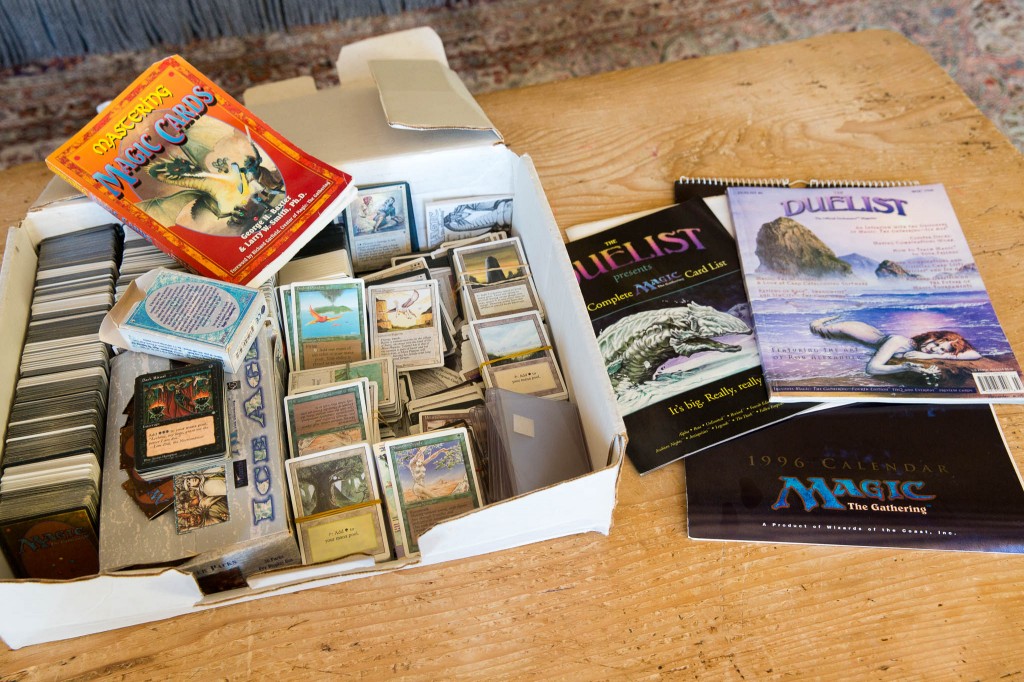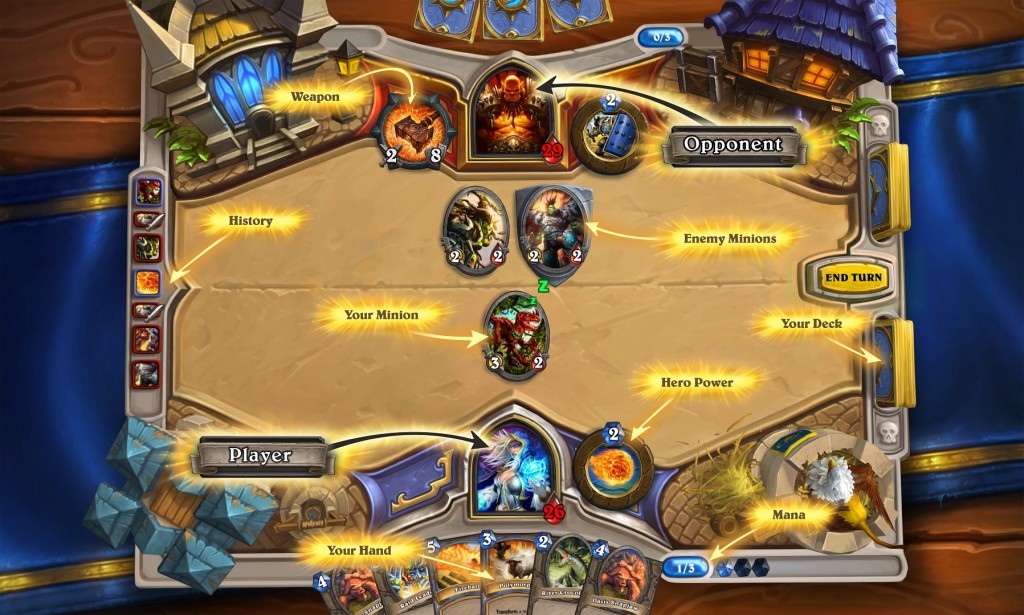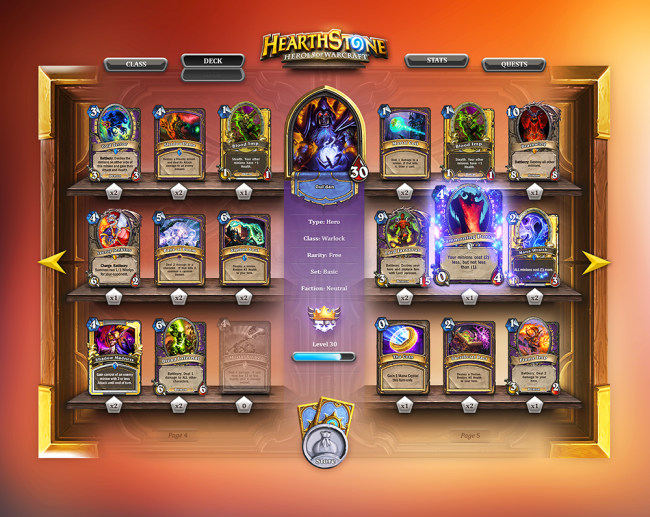I’m no stranger to Trading Card strategy games, having played Magic: The Gathering way back in 1993 (and fairly heavily through 1995 or 96). In recent years, lacking an enthusiastic series of human opponents, I periodically tried my hand at their latest computer incarnations. Most recently, this was IOS Magic 2013. This game was okay, but the designers felt too beholden to the specifics of the card game and not confident enough to invest in changes that would streamline the digital experience. Also, I’ve long felt that nearly all MTG expansion packs have strayed from their classic D&D flavored roots into that sort of bizarre out-there-and-too-cool-for-school style of western fantasy (all that dimensional and plane waker stuff).

To prove my old school cred, I dug up 20 year old box of magic cards, including beta dual manas, and a 1996 calendar!
Which brings us to Blizzard’s entry into this underdeveloped genre: Hearthstone. Basically, the Irvine powerhouse has taken the MTG formula, reskinned it with Warcraft characters, and streamlined it for online play. And while this may sound merely evolutionary — and it is — in typical Blizzard fashion, when they do something, they do it well.
Hearthstone is great fun and the gameplay itself extremely well balanced (considering its beta state) and fast and furious for a card game.
[youtube https://www.youtube.com/watch?v=QdXl3QtutQI]For those of you not familiar with this sort of game, it represents a “duel” between two fantasy characters. Each player constructs (or uses an off the shelf) deck of cards out of the pool of cards they own. Hearthstone’s decks are 30 cards, no more than two of any one type. You draw from this (shuffled) deck representing spells, abilities, and creatures to play them against your opponent as best you can. Generally cards require certain resources (mana) be spent to play, limiting the combinations you can cast in a given turn.
The biggest Hearthstone gameplay innovation (and I haven’t played enough Trading Card Duel games to know if it’s even a real innovation) is assigning decks a distinct class. In MTG, your deck design balances the flavor of mana versus the cost needs of various cards. I.e. it’s possible to “dual class” (or even triple class), but the odds of ending up with mismatched land and spell/creature cards becomes greater. In Hearthstone, you select one of the original nine Warcraft classes (Warrior, Rogue, Warlock, Mage, Druid, Shaman, Paladin, Priest, and Hunter — Deathknight and Monk being left for a future patch). Your deck must be constructed from cards specific to that class or the Neutral cards. This is quite clever as by giving each class unique mechanics found only in their specific cards, particular gameplay styles are created. Each class also has a unique 2 mana hero ability which can be used once per turn without consuming a card. This serves to both differential them and prevent the “nothing to do because I don’t have a usable card” problem. In Hearthstone, mana capacity notches up one turn at a time (unless affected by special cards). I.e. first turn you have one mana available, next turn two, and so on. This helps measure out the phase and progression of the game, being like a less frustrating version of playing your MTG lands.
The original World of Warcraft classes transition to this new medium impressively. For flavor, the art is very similar, cards are almost invariably named after WOW spells and creatures, and many are even accompanied by sound effects or voice snippets lifted right out of the MMO (Aaaaaughibbrgubugbugrguburgle!) . To a longtime WOW player like myself (9 years!), this is all pretty effective. I’ve played most WOW classes (all but Hunter and Shaman) and I’ve done enough PVP and raided exhaustively. For me,all the class abilities have a certain iconic quality. Add the fact that Blizzard based the mechanics of the individual classes around similar WOW abilities to color me impressed. For example, mage specific cards include: Arcane Explosion, Arcane Missles, Fireball, Polymorph, Cone of Cold, Flamestrike, Frost Nova, Frostbolt, Ice Lance, Mirror Image, Blizzard, Pyroblast, Mana Wyrm, Water Elemental, and Ice Block — all of which are fairly faithful to their WOW roots. And they world as a cohesive play feel and strategy that makes the transition into the card duel.
Being fully computerized, and not relying on mechanics that work with physical cards, Hearthstone is able to support more complex AOE and card modification. Spells can strike all or groups of cards for certain, random, or variable damage — and work in combination with modifiers like shield, stealth (can’t be attacked), taunt (must attack first), or enrage (extra abilities for damaged minions). Some of these mechanics, while possible on paper, would be tedious and slow to manage (annoying counters anyone?). The game doesn’t exactly push the hardware limits of a modern PC/Mac, but it features the typical slick Blizzard interface. Actions are fast, with satisfying sounds and effects. Plus they queue up nicely in a way that allows for rapid play out of multiple moves. This is in sharp contrast to a game like Magic 2013 which drags out each move with awkward and slow animations. Hearthstone lets you just go bang bang bang in a far more satisfying manner.
I suspect Blizzard is also (as usual) going to make a lot of money with Hearthstone. Not only is it fun, and technically free to play, but seamlessly integrated with Battlenet and your attached credit card. Basically, to add anything but the basic cards to your pool of available cards, you have to either be very good, very patient, or spend some money on packs of cards. These cost $1.50-$2 for a pack of 5! And there is no guarantee you’ll get cards you want. Although you can disenchant extra or undesired cards for dust and use them to craft any specific card. Getting substantial dust pretty much only comes from buying packs, so this mostly allows the player who spends $50+ a way to fill in for bad luck (thank God!). Certainly for $50-100 one could get the cards for any ONE deck one wanted (the cost is mostly in getting lucky or enough dust for the 1-3 legendaries many serious decks want).
There are a variety of modes and tricks to keep you coming back. Classes level up (giving you extra cards and bonuses). There are daily quests (you can have up to 3) that earn extra gold (which can be spent on cards or the Arena) and there is practice, normal, and ranked play modes. Possibly most interesting is the creative Arena mode. You have to pay (with dollars or gold) to enter, then you semi-randomly build a new deck, and play until you lose three times. The more wins in this time, the bigger the reward in gold, dust, and cards. The Arena seems currently, even for a sucky player, to be a slightly better value gold/dollars to cards, as it costs $1.50 and you seem to earn at least one pack. However, it does take an hour or two (you don’t have to play all at once). I’ve only done it twice, as I find playing with it’s fairly random decks a little frustrating compared to my carefully crafted normal mode ones.
Finally, you can always play with your Battle net friends, which will be cool once we get out of closed beta and more of mine try out the game. All in all, now that my main in WOW is ilevel 558 and I’d basically have to run Heroic raids for upgrades (almost), and given the fact that Hearthstone can be played in 5-10 minute chunks, I’m having a blast with it. If I feel motivated, I might even write up my experiences with the three late game strategies I’ve been working: Warlock, Mage Ice Control, and Pally Utility Control (sadly, as I’m a Lock in WOW, my Mage deck is doing much better).
| WOW Endgame series: Vanilla, Burning Crusade, Lich King, Cataclysm, and Pandaria. or read about Mists of Pandaria leveling. Latest hot post: Reaper of Souls Analysis! If you liked this post, follow me at: My novels: The Darkening Dream and Untimed |




